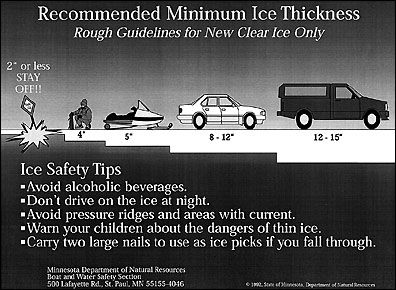DNR provides ice safety guidelines
On lakes in the southern half of the state, several cars, pickups, and SUVs have fallen through the ice. Snowmobiles have even broken through the ice.
"To date, no one has been killed, but that has been more due to luck than anything else," said Tim Smalley, DNR water safety specialist. Most vehicles that have gone through the ice so far have been parked too close together for current ice conditions, according to Smalley.
"Normally by now, folks would be driving on the ice with few problems, but we are having an abnormal year," he said.
 Ice is not really solid, like blacktop or concrete on the ground. Smalley said it might be better to think about the surface of a frozen lake as thinly rolled dough stretched over a hoop. Place a large marble on the dough and, like ice, it sags in the middle but it doesn't break. "If you put enough marbles next to each other on the dough, eventually it's going to give way," Smalley said.
Ice is not really solid, like blacktop or concrete on the ground. Smalley said it might be better to think about the surface of a frozen lake as thinly rolled dough stretched over a hoop. Place a large marble on the dough and, like ice, it sags in the middle but it doesn't break. "If you put enough marbles next to each other on the dough, eventually it's going to give way," Smalley said.
The DNR issues these ice thickness guidelines for new clear ice. For ice that is milky or white - caused by air bubbles due to warm weather - ice should be twice as thick to provide the same strength.
The Koochiching County Sheriff's Office closed Rainy Lake in northern Minnesota on Tuesday, Dec. 27, to car and truck traffic due to poor ice conditions. "If it's that bad on the Canadian border waters, imagine what its like on some of the lakes farther south," Smalley said. "If we get a nice cold snap, conditions could improve in a few days."
Scientists who study ice recommend parking passenger-size vehicles 60 feet apart on eight inches of new clear ice, not the door-to-door parking lot style that is often seen on Minnesota lakes. Another issue is much of the ice now is white or "milky" ice rather than stronger clear ice.
"The milky appearance comes from air bubbles, trapped in between ice crystals, which weakens the ice considerably," Smalley said. "You need twice as much of the white ice as you do clear ice."
Guidelines recommend a bare minimum of eight inches of new clear ice for small- to medium- size cars, SUVs, and pickup trucks. Since white ice is only half as strong as clear ice, a vehicle may need 16 or more inches of white ice.
DNR officials recommend that people who are planning a day on the ice check with a local bait shop or resort on the lake where they are headed for the most current ice conditions.
For those who must drive on ice, the DNR offers these safety tips.
*Check the ice often, at least every 150 feet or more often if the ice thicknesses are found to be quite variable.
*Leave at least 60 feet between vehicles parked on ice and drill a hole in the ice near your car. If water overflows the edges of the hole, move the vehicle immediately; it is starting to sink. Also, if you see concentric cracks circling around the perimeter of the vehicle, it is time to move it.
*Don't drive on the ice at night if at all possible; a newly opened hole might not be visible in low light conditions.
*Leave windows down, seatbelts unbuckled, and doors ajar for a quick exit if the vehicle breaks through.
*Drive across wet cracks in the ice as close to perpendicular as possible and assume the ice strength is one-half that of new solid clear ice.
*Bail out as soon as the car starts to break through. Don't wait for it to settle to the bottom. Cars often turn upside down as they sink, which combined with freezing water, make breath-holding more difficult and limit visibility. Mud pushing against the doors can make escape nearly impossible.
*Don't drive faster than 15 miles per hour. Faster speeds can cause waves in the ice, much like a boat's wake in the summer, that can cause already weak ice to shatter.
*If there has been a recent large snowstorm, the added weight of the snow represents an added stress on the ice. Heavy snow may force the top of the ice to become submerged. Water then seeps up through surface cracks causing a layer of slush. Until the slush refreezes, keep vehicles off the ice.
For more information on ice safety, contact the Minnesota DNR tollfree at 1-888-MINNDNR (1-888-646-6367). Anyone with Internet access can go online to www.dnr.state.mn.us and click on "Ice Safety."
Contact the author at editor@paynesvillepress.com • Return to Sports
Home | Marketplace | Community